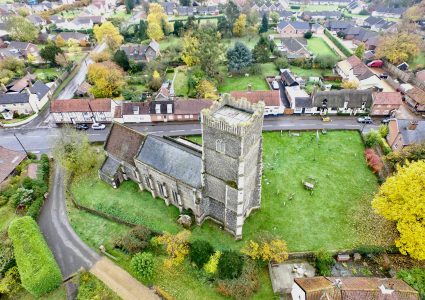St. Mary’s Church Badwell Ash
The earliest records for the priests in charge of St. Mary’s date back to 1338, during the reign of Edward III, when the Austin Canons of Ixworth were the owners of the living of the parish of Ashfield Parva or Badwell Ash. As a result, the first 200 years in this listing show the Priors of Ixworth Priory as overseeing St. Mary’s but, to date, no schedule has been found showing who were the actual priests in charge of Badwell Ash.
After Henry VIII dissolved the Priory at Ixworth 1537, a new Chaplain Williamus Smyth, was appointed to the Parish of Badwell Ash in 1555. The remainder of the listing is a schedule of the known curates, priests and other incumbents up to the present time.
| Priors of Ixworth | ||||||
| William de Ixworth | died 1338 | Prior of Ixworth | ||||
| Roger de Kyrkested | 1338 | Prior of Ixworth | ||||
| Nicholas de Monesle | 1362 | Prior of Ixworth | ||||
| John de Hereford | 1389 | Prior of Ixworth | ||||
| John de Welles | 1395 | Prior of Ixworth | ||||
| Thomas Lakynghithe | 1430 | Prior of Ixworth | ||||
| Reginald Tylney | 1439 | Prior of Ixworth | ||||
| William Dense | 1467 | Prior of Ixworth | ||||
| John Ive | 1484 | Prior of Ixworth | ||||
| Godwin Bury | 1493 | Prior of Ixworth | ||||
| Richard Gotts | 1504 | Prior of Ixworth | ||||
| John Gerves | died 1536 | Prior of Ixworth | ||||
| William Blome | elected 1536, surrendered same year | Prior of Ixworth | ||||
|
The suppression of the Ixworth Priory under Henry VIII’s Act of Supremacy took place in February 1537 when Prior Blome was given a pension of £20 p.a. The other 15 Canons were cast out penniless. In July 1538 the site of the priory was given to Richard Coddington and his wife Elizabeth in exchange for his lands in Surrey which Henry VII required to build Nonsuch Palace.
|
||||||
| Priests, Curates and Vicars of Badwell Ash after the Dissolution | ||||||
| Smyth, Williamus | 1555 | Chaplain | ||||
| Feaser, Richus | 1584 | Stipendiary Curate | ||||
| Wolfenden, Jacobus | 1584 | Curate | ||||
| Priests, Curates and Vicars contd. | ||||||
| Maninge, Petrus | 1597 | Curate | ||||
| Maninge , Jeremias | 1603 | Parochial Chaplain | ||||
| Maninge, Petrus | 1605 | Curate | ||||
| Hunt, Holefernes | 1636 | Curate | ||||
| Doughty , Georgius | 1685 | Curate | ||||
| Burrell , Nathaniel | 1702 | Curate | ||||
| Esprevier , Samuelis | 1707 | Curate | ||||
| William , Richard | 1740 | Curate | ||||
| Hughes , William | 1743 | Curate | ||||
| Nunn , Robert | 1756 | Perpetual Curate | ||||
| Nunn , Robert | 1756 | Curate | ||||
| Casborne , John Spring | 1787 | Perpetual Curate | ||||
| Nunn , Robert | 1787 | Perpetual Curate | ||||
| Rogers , Arthur | 1813 | Curate | ||||
| Rogers , Arthur | 1813 | Curate | ||||
| Casborne , John Spring | 1823 | Perpetual Curate | ||||
| Norgate , Burroughes Thomas | 1823 | Perpetual Curate | ||||
| Ray, Henry | 1847 | Perpetual Curate | ||||
| Lee, Charles | 1879 | Perpetual Curate | ||||
| Roe, Robert G | 1891 | Perpetual Curate | ||||
| Hutchison, George James | 1891 | Vicar | ||||
| Linnington, Richard | 1902 | Vicar | ||||
| Dewing, Richard Standby | 1909 | Vicar | ||||
| Moilliet-Fanshawe, Percival | 1919 | Vicar | ||||
| Douglas, John Casson | 1945 | Vicar | ||||
| Thomas, Owen Edgar | 1957 to March 1964 | Vicar | ||||
| Adams, Frank | March 1964 to Feb 1970 | Vicar | ||||
| Leffler, Christopher | 1973 to April 1982 | Vicar | ||||
| Pattison, George Linsley | April 1983 to April 1990 | Vicar | ||||
| Potter, Frank Higton | May 1990 to March 1996 | Vicar | ||||
| Clarke, Martin Geoffrey | March1997 to Sept 2009 | Vicar | ||||
| Interregnum | Oct 2009 to March 2011 | |||||
| Sam Long | April 2011 to Aug 2014 | Vicar | ||||
| Interregnum | Sept 2014 to March 2017 | |||||
| Philip Merry | April 2017 to Aug 2023 | Vicar | ||||
| Interregnum | Sept 2023 to Sept 2024 | |||||
| Catriona Brinkley | October 2024 to | Curate in Charge | ||||
The rather peculiar term Perpetual Curate simply means a clergyman officiating in a parish to which he had been nominated by an impropriator, a lay person in possession of ecclesiastical property. An impropriator is a lay person who has taken over a benefice or ecclesiastical property and made his own. He would effectively have impropriated or appropriated the revenues of the church in a village or town, usually as a bequest granted by the bishop.
A Perpetual Curate had to be licensed by the bishop and could be a lay person nominated by the owner of the parish. His income came from a stipend or salary paid by the owner of the parish and not as a result of the possession of tithes. After the dissolution of the monasteries, land owned by the monasteries was distributed to ordinary individuals and these lay impropriators were required to nominate persons to serve the parish as priests and curates. Such appointments became ‘perpetual’ in that the incumbent could only be removed by the revocation of the ordinary’s licence.





